Te Aro House (Former)
Building A – 53 Dixon Street, Te Aro House,James Smith, Burlington Arcade, Woolworths, Deka; 82 Cuba Street, 84 Cuba Street, 86 Cuba Street, 88 Cuba Street, 90 Cuba Street

Photo: WCC - Charles Collins, 2014


National Library Reference: James Smith's shop, Te Aro House, corner of Cuba and Dixon Streets, Wellington. Ref: 1/2-003732-F. Alexander Turnbull Library, Wellington, New Zealand. http://natlib.govt.nz/records/22342067
![The Alexander Turnbull Library note that this photographs shows Te Aro House after the fire of 18 April 1885 but it is in fact a record of the earlier 1879 Opera House fire. Photographer James Bragge (1833 – 1908) staged a re-enactment of the … “James Smith Limited during the Imperial Opera House fire. Staff are hanging blankets out of windows [presumably these are wet blankets to protect the building from the fires nearby] and in the foreground a fireman is connecting a hose to the mains supply.” Te Papa webpage accessed June 2012. http://collections.tepapa.govt.nz/objectdetails.aspx?oid=127501 James Smith Ltd, Te Aro House after the fire. James Smith Ltd :Photographs of personnel, activities and shops. Ref: PAColl-3332-1-3. Alexander Turnbull Library, Wellington, New Zealand. http://natlib.govt.nz/records/23084720](/~/media/heritage/buildings/0-150/076/image4.ashx?mw=671&mh=415)
Te Aro House after the 1879 Opera House fire when photographer James Bragge (1833 – 1908) staged a re-enactment of the … “James Smith Limited during the Imperial Opera House fire. Staff are hanging blankets out of windows [presumably these are wet blankets to protect the building from the fires nearby] and in the foreground a fireman is connecting a hose to the mains supply.”
References:
Te Papa webpage accessed June 2012. http://collections.tepapa.govt.nz/objectdetails.aspx?oid=127501
William Main, "Wellington Through a Victorian Lens" (Wellington: Millwood Press, 1972) page 71
James Smith Ltd, Te Aro House after the fire. James Smith Ltd :Photographs of personnel, activities and shops. Ref: PAColl-3332-1-3. Alexander Turnbull Library, Wellington, New Zealand. http://natlib.govt.nz/records/23084720 "

National Library reference: Te Aro House, Wellington. Crown Studios Ltd :Negatives and prints. Ref: 1/1-038758-F. Alexander Turnbull Library, Wellington, New Zealand. http://natlib.govt.nz/records/23042148
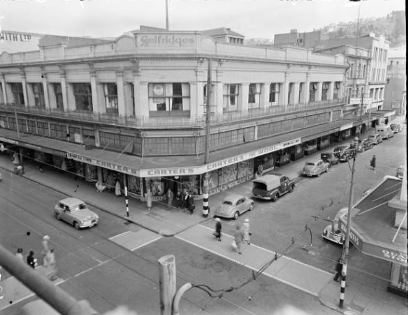
National Library referece: New Woolworths shop, Cuba Street, Wellington. Negatives of the Evening Post newspaper. Ref: 114/267/02-G. Alexander Turnbull Library, Wellington, New Zealand. http://natlib.govt.nz/records/23008243
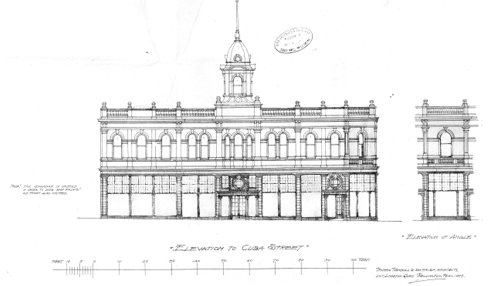
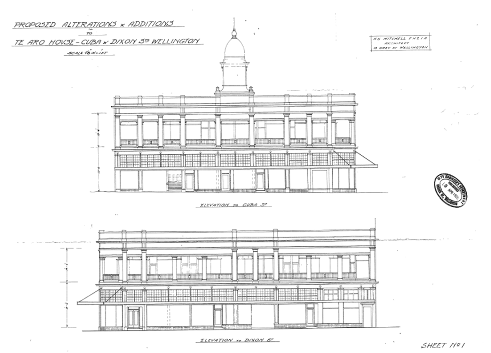
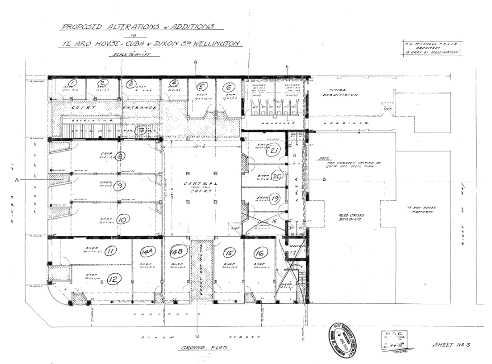
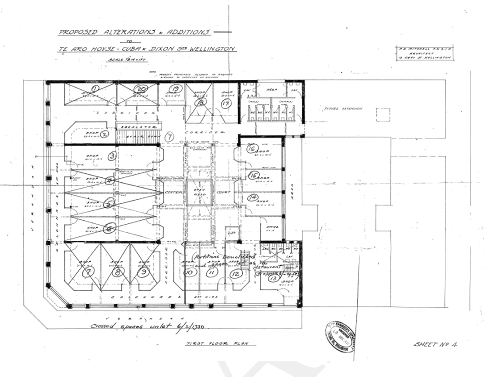
-
Constructed
1886
-
Heritage Area
-
Architect(s)
-
Builder(s)
Harold Edwards
-
The building is a much-modified stripped Classical style commercial building.
The building was constructed in 1886 and any vestigial remains of the original fabric are among the oldest masonry still standing in central Wellington.
The building site has an association with Mary Taylor, a C19th feminist, music teacher, businesswoman and writer, and her brother William Waring Taylor. Mary Taylor is known for her friendship with author Charlotte Bronte.
The building has been occupied by several prominent local and national retail establishments including James Smith, and Woolworths New Zealand.
The building site has been occupied continuously since circa 1850 and has archaeological value.
-
Downloadable(s)
-
close
History
-
Mary and Ellen Taylor established a drapery and clothing shop on the corner of Cuba and Dixon streets in c.1850. Mary Taylor (1814-1893) an early nineteenth century feminist, music teacher, businesswoman and writer is now better known for her friendship with novelist Charlotte Bronte than for her own writing. Taylor was, however, a strong proponent of a woman’s right to choose work rather than marriage and arrived in New Zealand in 1845 to escape from the middle class expectation that she marry or find suitable women’s-work. Charlotte Bronte wrote that Taylor believed “'she cannot and will not be a governess, a teacher, a milliner, a bonnet-maker nor housemaid' and that she would fare better in New Zealand.” Mary and Ellen Taylor’s business was successful and Mary was able to purchase land in the area of Cuba, Eva and Leeds Street. Taylor remained in Wellington until circa 1860, when she returned to England. Her brother William Waring Taylor lends his name to Waring Taylor Street in Wellington.
The business was sold to James Smith in 1866. James Smith was born in Edinburgh and arrived in New Zealand in 1863 and shortly after worked as the manager in the drapery department of Messrs. W. and G. Turnbull and Co. Smith purchased Te Aro House in 1866 and went into business with Walter Turnbull in 1877 to form the wholesale firm of Turnbull, Smith and Co. and this business appears to have taken over the “drapery branch of Messrs. W. and G. Turnbull and Co.” Smith retired in 1888 from the wholesale business but continued to run Te Aro House until at least 1897. Smith also has an association with the Presbyterian Church notably St James’ and St John’s
The original timber shop and living accommodation was replaced with a substantial new timber shop in 1870. This building survived the Manners Street fire of 1879 that destroyed the Opera House and some 30 other buildings in Dixon and Cuba Streets. Te Aro House was eventually destroyed by fire on the 18 April 1885. It was rebuilt, probably to a design by Thomas Turnbull, and re-opened on the 30th September or the 01st October 1886.
The new building incorporated fire protection devises including “substantial brick walls dividing departments, and perforated pipes running down the ridges of the building which would enable the building to be flooded in the event of fire.” The building was further altered to a scheme designed by Thomas Turnbull & Son in 1909.In 1920 James Smith purchased the building at the corner of Manners and Cuba Street that is now the better known of the two James Smith’s department stores on Cuba Street. Te Aro House was converted to the Burlington Arcade in 1928 for R Hannah Ltd. The alterations were designed by architect A.S Mitchell and constructed by Harold Edwards of 250 Lambton Quay for an estimated sum of £18,500. Presumably the Burlington Arcade was named for and modelled after the more famous Burlington Arcade in London.
The Burlington Arcade refurbishment included the replacement of the ornate 1886 Classical façade with a new modern (then) fashionable façade in the Stripped Classical style. The ground floor of the existing building was converted into “mall” of small shops, and a new first floor was constructed with a reinforced concrete structural frame. A large “lantern” light was installed over a two storey atrium to light the corridors and internal shops on the first and second floors. It is likely that the cupola and tower on the Cuba Street façade were removed at around the time of these refurbishment works.
The opening of the new Burlington Arcade was soon followed by the Great Depression, and drawings of the building in 1930 show that almost all of the second floor retail tenancies were vacant. The Burlington Arcade continued in use until 1951 when Woolworths purchased the building and converted the arcade back to a large, open-plan, department store. Woolworths in Australasia appears to have no connection with its namesake in the USA. It was established in Sydney in 1924 and Percy Christmas (one of the five founding ‘partners’) appears to have established a Woolworths New Zealand in 1929 with the first New Zealand store in Wellington, probably at 32 Cuba Street.
Trams were withdrawn from service along Cuba Street in 1964 and in 1969 the street was opened as the pedestrian-only Cuba Mall. Cuba Mall (including the Bucket Fountain) was designed by Burren and Keen, architects and town planners
Woolworths (NZ) Ltd was sold to L.D. Nathan in 1979 and in 1988 LD Nathan re-named its 60 Woolworths (and some McKenzie) variety merchandise stores to the DEKA brand. DEKA purchased the Farmers Trading Company in 1992 and, moved the operation of DEKA to the adjacent Farmers’ Building at 94-102 Cuba Street at sometime around this date. Both the Farmers and DEKA buildings were sold in c.1997 to Century City Holdings owned by developer Terry Serepisos. Century Holdings applied for resource consent in 2006 to construct a 10+ storey addition to the former Te Aro House, and the consent expired in 2011. Receivers of Century City Holdings offered the Farmers and Deka ‘blocks’ on Cuba Mall for sale in 2012.
-
Modifications
close
-
1850
-
First known building on site – a house and shop for Mary and Ellen Taylor
-
c.1870
-
Second known building on the site – a shop for James Smith
-
1886
-
This is likely to be the Thomas Turnbull designed building for James Smith Arch 1901 (OC4361).
-
1909
-
Significant modifications designed by William Turnbull for James Smith / Te Aro House. Remodelling incl. new windows, verandah, alter & new staircase, archways (OC8366),
-
1928
-
Building modified to become the Burlington Arcade for R.Hannah Ltd to a design by A.S Mitchell. Extensive alts & remodelling, tower removed, façade refashioned, interior lightwell, new verandah (B5222)
-
1937
-
Shop front alts (B16596)
-
1951
-
Building purchased by Woolworths. Fitout for Woolworths store and generator house both (B31601, B32184)
-
1974
-
Extension Extension (C41035)
-
1989
-
Structural strengthening Structural strengthening (E17964).
-
2011
-
30/08/ Bdg StrengthInv Building A 30/08/ Bdg StrengthInv Building A (Old DEKA building Notice Exp 31/08/2026 SR 163172
-
-
Occupation History
close
-
1891 - 1925
-
James Smith, draper importer, (Te Aro House) (Stones1891-92, 1895, 1900, 1905,1910-11, 1915-16, 1920, 1925)
-
1930 - 1935
-
Burlington Arcade - various retailers, predominately clothing related (Stones1930,1935),
-
1940 - 1951
-
Selfridges Department Store (Stones1940, 1945, Wises1950-51),
-
1955 - 1990
-
Woolworths Department Store (Wises1955, 1961-62, 1967-68, 1971-72, not listed 1975, 1980, 1985). Not listed 1990.
-
-
-
close
Architectural Information
-
Building Classification(s)
close
Not assessed
-
Architecture
close
The former Te Aro House is a two storey commercial (retail) premises constructed in 1886 and re-modelled in 1928. The decorative style of the façade (which dates from 1928) is a well-proportioned example of Stripped Classicism and the elevation features plain shallow pilasters, a simple parapet and cornice. There are small scrolled brackets that support the cornice and the cornice features a moulding of dentils. The windows are square headed and flanked by secondary pilasters.
The building was substantially altered in 1886, 1909, 1928, 1951 and again when Woolworths/Deka departed the building in the 1990s. -
Materials
close
All information from 1928 Specification: -
Stones and Wises
Rendered brick masonry external walls
Reinforced concrete structure – footings, walls, piers, columns, girders, beams
Reinforced concrete – floors (ground and first) and stair
Structural steel - beams and joists (some are encased in concrete)
Corrugated iron (or mild steel)
Windows – steel sashes
Timber roof trusses – all (1886) roof trusses to be reused/adapted where possible
-
Setting
close
Block 3 Cuba Street - from the WCC Cuba Street Heritage Area report for DPC 48
The building at 84 – 92 Cuba Street occupies a prominent corner site at the entrance to Cuba Mall. Cuba Mall (established in 1969) is a public space paved with clay pavers and is a pedestrian mall closed to (most) vehicular traffic. Cuba Street Blocks 3 and 4 have the highest concentration of Edwardian commercial buildings in Cuba Street and consequently have the highest architectural, heritage and streetscape value in the Cuba Street Heritage Area, and the most important of the surviving Edwardian buildings are found on this block. The characteristic scale of Block 3 is three tall stories, a level defined by the Wellington Working Men’s Club and reflected in the Farmers Building, Hotel Bristol, Barbers Building, and others (although there are some two storied buildings and one building has four storeys). Most of the buildings in Block 3 have flat-roofed verandahs attached at the first floor which have a strong similarity of form and scale. The street edge reads very strongly in this block with nearly all the buildings conforming to the common line.
-
Building Classification(s)
close
-
close
Cultural Value
The building is a much-modified stripped Classical style commercial building.
The building was constructed in 1886 and any vestigial remains of the original fabric are among the oldest masonry still standing in central Wellington.
The building site has an association with Mary Taylor, a C19th feminist, music teacher, businesswoman and writer, and her brother William Waring Taylor. Mary Taylor is known for her friendship with author Charlotte Bronte.
The building has been occupied by several prominent local and national retail establishments including James Smith, and Woolworths New Zealand.
The building site has been occupied continuously since circa 1850 and has archaeological value.
-
Aesthetic Value
close
-
Architectural
Does the item have architectural or artistic value for characteristics that may include its design, style, era, form, scale, materials, colour, texture, patina of age, quality of space, craftsmanship, smells, and sounds?
The building is a much-modified stripped Classical style commercial building
-
Group
Is the item part of a group of buildings, structures, or sites that taken together have coherence because of their age, history, style, scale, materials, or use?
The building makes a positive contribution to the significant collection of heritage buildings that form the Cuba Street Heritage Area.
-
Townscape
Does the item have townscape value for the part it plays in defining a space or street; providing visual interest; its role as a landmark; or the contribution it makes to the character and sense of place of Wellington?
The building occupies a prominent corner site at the entrance to Cuba Mall.
-
-
Historic Value
close
-
Association
Is the item associated with an important person, group, or organisation?
- The building is a rare example of a building with significant social history and the site has been occupied by a retail establishment continuously since the 1850s.
- The building site has an association with Mary Taylor, a C18th feminist, music teacher, businesswoman and writer, and her brother William Waring Taylor. Mary Taylor is known for her friendship with author Charlotte Bronte.
- The building has an association with James Smith, a significant local business owner.
- The building has an association with James Smith’s department store – a significant local business
- The building has an association with Woolworths NZ – a national chain of ‘variety merchandise’ stores
-
Association
Is the item associated with an important historic event, theme, pattern, phase, or activity?
- The building site is associated with the development of retail business in Wellington from the colonial period to the late C19th century
- The building is associated with the development of retail business in Wellington from the late C19th to current day.
- The building site is associated with the early C19th feminist movement
-
-
Scientific Value
close
-
Archaeological
Does the item have archaeological value for its ability to provide scientific information about past human activity?
- The building site has been occupied continuously since circa 1850 and has significant archaeological value
-
Technological
Does the item have technological value for its innovative or important construction methods or use of materials?
• The building may have some technological value for the (1928) reinforced concrete structural scheme.
-
-
Social Value
close
-
Identity Sense of place Continuity
Is the item a focus of community, regional, or national identity? Does the item contribute to sense of place or continuity?
- The building façade has remained (relatively) unchanged on the site for over 80 years and contributes to the sense of place and continuity of the Cuba Street Heritage Area.
- The building site has been occupied by a retail premises for over one hundred and fifty years.
-
-
Level of Cultural Heritage Significance
close
-
Authentic
Does the item have authenticity or integrity because it retains significant fabric from the time of its construction or from later periods when important additions or modifications were carried out?
- The 1928 building facades to Dixon and Cuba Street are relatively unmodified and retain substantial areas of original building fabric. There is evidence that some of the earlier 1886 building fabric survives, particularly parts of the building roof structure.
-
Rare
Is the item rare, unique, unusual, seminal, influential, or outstanding?
- The building site is a rare example of site that has been continuously occupied by a retail premises for over one hundred and fifty years
- Some of the building’s fabric dates back to 1886 and so the building is among the oldest commercial structures in Wellington built in masonry in the wake of the 1855 earthquake.
- The building site has significant social history particularly because of the connection with the author Charlotte Bronte
-
-
Local / Regional / National / International Importance
close
Not assessed
-
Aesthetic Value
close
-
close
Site Detail
-
District Plan Number
16/ 76
-
Legal Description
Lot 3 DP 44277
-
Heritage New Zealand Listed
Not listed 2012
-
Archaeological Site
Pre 1900 building
-
Current Uses
unknown
-
Former Uses
unknown
-
Has building been funded
No
-
Funding Amount
Not applicable
-
Earthquake Prone Status
124 Notice
-
-
close
Additional Information
-
Sources
close
- OF TE ARO HOUSE by FIRE. Evening Post, 20 April 1885
- Opening of Te Aro House. Evening Post, 1 October 1886
- The Cyclopedia of New Zealand [Wellington Provincial District] 1897
- Dominion, 3 September 1920
- Ward, Louis E. , Early Wellington, Whitcombe and Tombs Limited : Auckland., 1928
- Farewell to Woolworths born in Cuba Street in 1929, Press Release – Progressive Enterprises
- Main, William. Wellington Through a Victorian Lens, Wellington: Millwood Press, 1972
- Evening Post 26/8/1997
- Rebranding & Closure Of DEKA Stores, Thursday, 15 March 2001, 2:23 pm, Press Release: Supplied via Mediacom press release distribution.
- Yska, Redmer. Wellington: Biography of a City, Auckland : Reed Publishing Ltd, 2006
- Schouten, Hank. “Jewel in Serepisos’ empire for sale”, Dominion Post 23/05/2012
- WCC Cuba Street Heritage Area report for DPC 48
- Archived copy of DEKA Website from 2001
- 'Grocery shopping',
- WCC Archives - report by Helen McCracken – 1998; Gábor Tóth, Cuba Street and the Brontë Connection, 1998; Thomas Ward map, circa 1890; specification and plans
- Hughes, Beryl. 'Taylor, Mary - Biography', from the Dictionary of New Zealand Biography. Te Ara - the Encyclopedia of New Zealand
- Laurenson, Helen. 'Department stores and shopping malls', Te Ara - the Encyclopedia of New Zealand
- NZHPT professional biographies
- Progressive Enterprises Ltd website accessed 14 June 2012
- Stones and Wises
- Te Papa webpage
- Wikipedia
- Technical Documentation close
-
Footnotes
close
Not available
-
Sources
close
Last updated: 4/20/2017 4:03:00 AM
